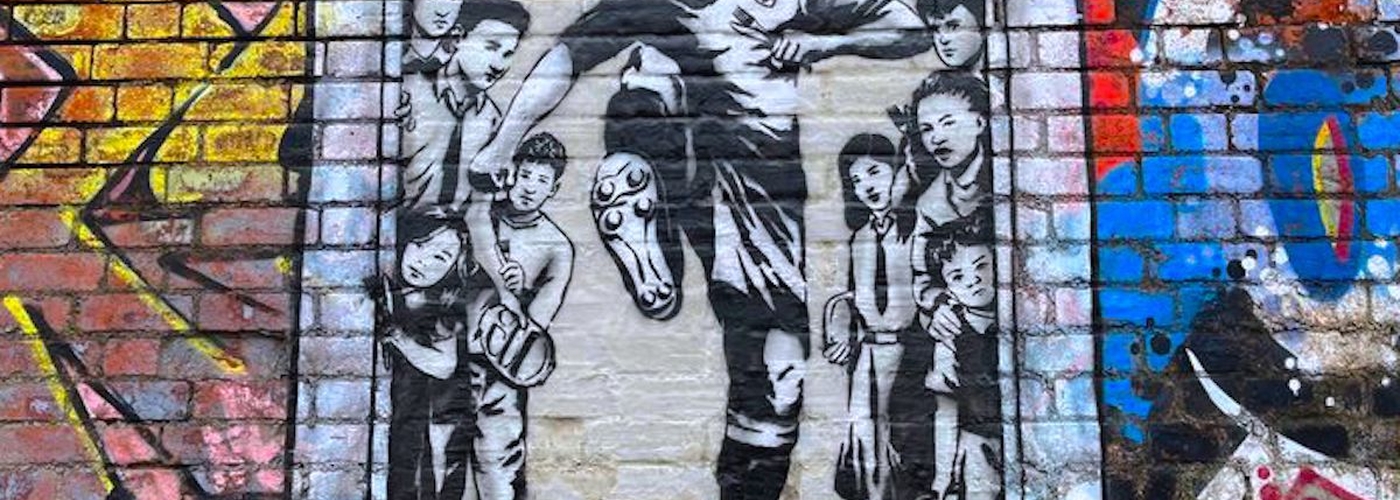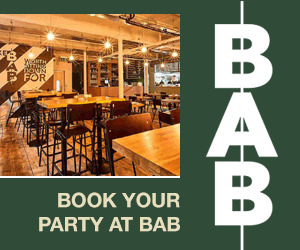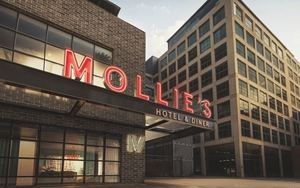Not everyone likes Rebel Bear’s work
When a new piece of street art popped up overnight like a particularly vibrant mushroom this weekend, an old debate about the validity of the genre as a whole also unexpectedly resurfaced.
The piece, located on a wall by the canal not far from Old Trafford football club, depicts Marcus Rashford kicking down the door to Number 10, watched by a group of young children. A trompe l’oeil effect was created by laying a real 'number 10'-style door in front of the artwork.
The artwork was created by Rebel Bear, a Glaswegian street artist who reportedly works while wearing a pink bear outfit. According to Rebel Bear's bio, his oeuvre "addresses politics, love, human emotion and comments on the absurdity of the world we have created."

Rebel Bear said of the piece: “The bear's running a little late with this one, but I always wanted to pay homage to Marcus Rashford who refused to take no for an answer, booted No.10 Downing Street off its hinges and spoke up for those who are too often not heard.”
Marcus Rashford is a natural subject for street art, which often focuses on heroic figures exhibiting the kind of strength and moral purpose that would attract a Soviet-era iconographer. Political and social commentary is also a favourite topic, though as we shall see, this doesn't often involve a repudiation of capitalism.
Art of this kind will be familiar as bricks to most readers of Confidentials. You can't move in the city centre (or for that matter, many surrounding towns and suburbs) for street murals, ranging from photorealistic depictions of zeitgeist-y people to brightly coloured abstract works to images of the natural world (bees are popular for some reason). Though street art takes on elements of graphic art and typography, and can be inspired by its more rough and ready ancestor, graffiti it is most definitely not.
An old debate
At least one commentator seems to be unfamiliar with the concept though. While reactions on Facebook and Twitter about the new artwork were in the main very positive, one disagreement has broken out about the artwork.
The saga began when Trafford Council leader Andrew Western commented on Twitter: “Proud we have this in Trafford.”
Trafford Conservatives responded: “Only in Trafford can we have a leader who is promoting graffiti and fly tipping as a thing to be 'proud' of. So, if you have received a fine recently for either arguably you could seek to get it reversed given Andrew Western’s clear approval of both.”
Mr Western tweeted his reply: “Genuinely interested in this. Apparently I shouldn’t approve of this excellent street art celebrating @MarcusRashford taking on the Tories. Am I wrong, or do @traffordblue just not want a reminder of their refusal to feed vulnerable kids during a pandemic?"
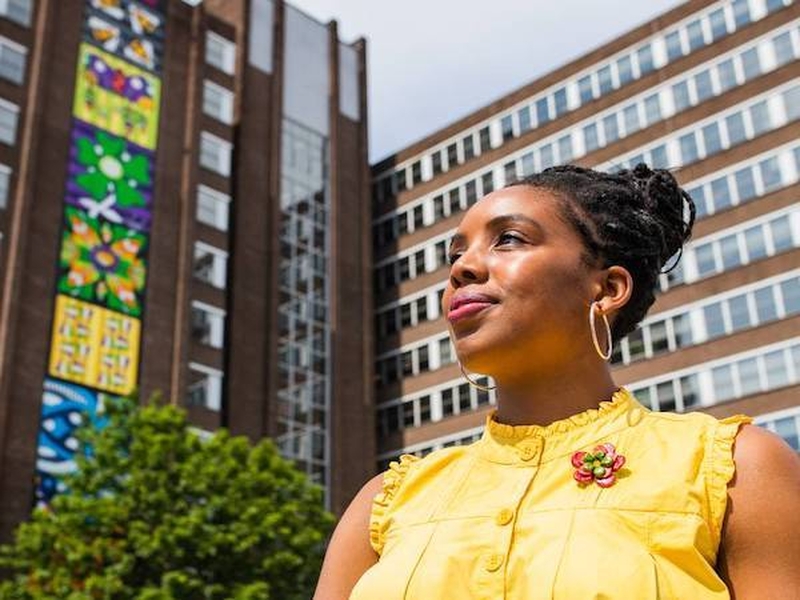
Genuinely interested in this. Apparently I shouldn’t approve of this excellent street art celebrating @MarcusRashford taking on the Tories. Am I wrong, or do @traffordblue just not want a reminder of their refusal to feed vulnerable kids during a pandemic? pic.twitter.com/OOxb4hoy3N
— Andrew Western (@AndrewHWestern) March 20, 2021
The disagreement is an old one - disruptive creativity versus maintaining public order. But that oppositional way of thinking is out of date and rather surprising, given the context. For a start, the canal area near Old Trafford is hardly an area of outstanding natural beauty.
On top of that, in this world of non-fungible tokens and Nyan Cat, street art is now as solidly conventional as an oil painting of a vase of flowers. The very fact it is now beloved of business demonstrates how far it has come from its edgy outsider days, something which should appeal to the Conservatives.
Street art meets business
Examples of business's fondness for street art are legion. Just a few minutes' walk away from Rebel Bear's work is Trafford House. Property developer Bruntwood, which owns the offices and commercial space, commissioned artist Venessa Scott to paint a bright tapestry-style mural down the side of the building, inspired by the life of Sylvia Pankhurst. Bruntwood often sponsors young artists and even maintains a relationship with the Manchester School of Arts. A stone's throw again and there is lovely mural of flowers and bees painted by Caroline Daly as a part of Gorgeous Gorse Hill, a community project that aims to inject colour into the area around Old Trafford.
The celebration of local heroes is also a theme in a new set of murals in Collyhurst. Comedian Les Dawson, boxer Mike Brodie and several local footballers feature alongside local wildlife, all designed and created by artists Kelzo and Entise.
The art was funded by Northwards Housing and the Far East Consortium. You might recognise Far Eastern Consortium as the firm leading the Northern Gateway project. Thousands of homes are set to be built across the 50-acre site, currently one of the most deprived areas of the city, under a joint venture with Manchester City Council.
The deal is said to be worth anywhere between £1 billion and £4 billion, so sponsoring a street art project represents mere pennies to the developers. What they get in return is a quite literal facade of a vibrant cultural life - important when you are soon to be selling apartments.
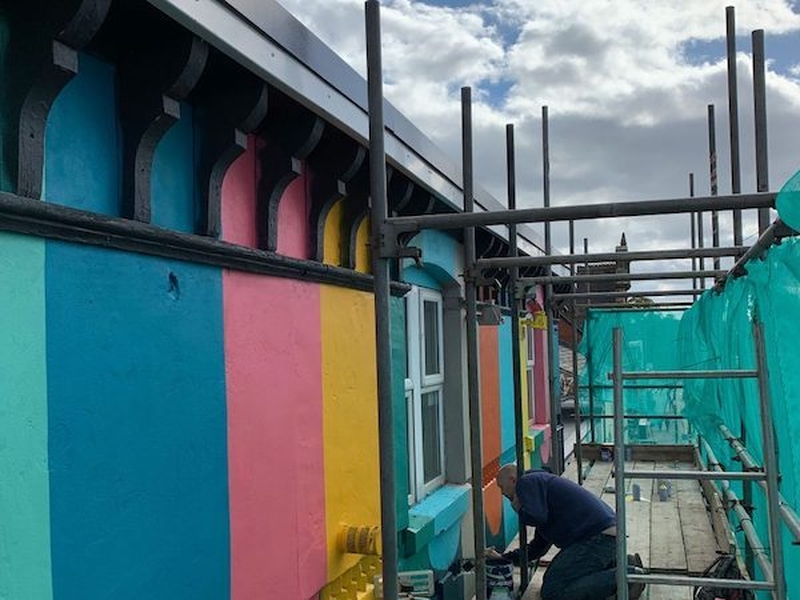
There are countless other examples of businesses investing in street art, adorning the inside and outside of shops and offices as well as larger commercial spaces like Trafford House. One look at Qubek's commercial instagram feed shows he is a very busy man indeed.
This is all to the good - now more than ever it is important for artists to get paid for their hard work and talent and where is that money going to come from if not business? In this regard, street art is hardly different from other signifiers of gentrification, and this kind of patronage is nearly as old as art itself. It is possible that even the cave painters got a few extra hunks of mammoth meat from the most successful hunters in exchange for transforming the area into a des res.
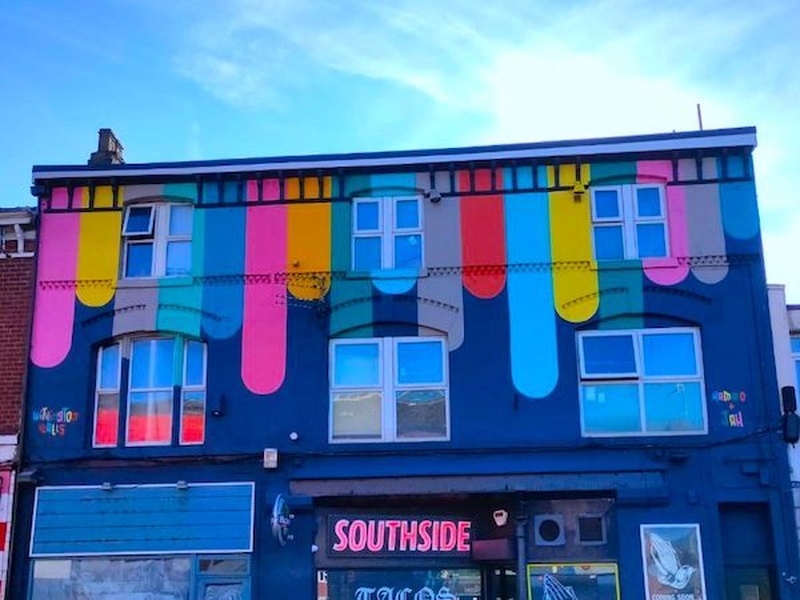
Withington's walls
In truth, street art is not just in the streets or by the sides of canals now. It is everywhere from the shutters of estate agent offices to schools to bars to children's bedrooms to hospitals. Its bright, punchy style is so popular and accessible (and social media friendly) that it has invaded the fabric of our lives.
Sticking to the outdoors, however, while the Northern Quarter has a reputation as the home of Manchester’s street art, a veritable outdoor gallery has sprung up on the streets of Withington.
Withington Walls is a project that, like Gorgeous Gorse Hill, aims to reinvigorate the area by harnessing its vibrancy and popularity. The project is crowdfunded, mostly by locals but with some extra boosts from businesses, and has a range of artists and styles, from the Memphis-inspired graphic work of Caroline Dowsett and the bright cartoon styles of Hammo to a portrait of our old friend Marcus Rashford, this time painted by Akse.
The style of TEAone (also known as Gavin Renshaw) is defiantly traditional but looks like something new when applied to the walls of the power station on Marriot Street. Entitled 'Song Without Words' (taken from the name of a composition by Frederick Mendelssohn) the piece is inspired by the story that the famous composer played the organ in St Paul's Church, just across the road. According to the Withington Walls Instagram: "We hope he [the artist] doesn't mind us telling you this but he said that he wanted to paint an orchestra - in part - because it's a group of people coming together to create something beautiful that is bigger than themselves, which is how he saw Withington Walls."
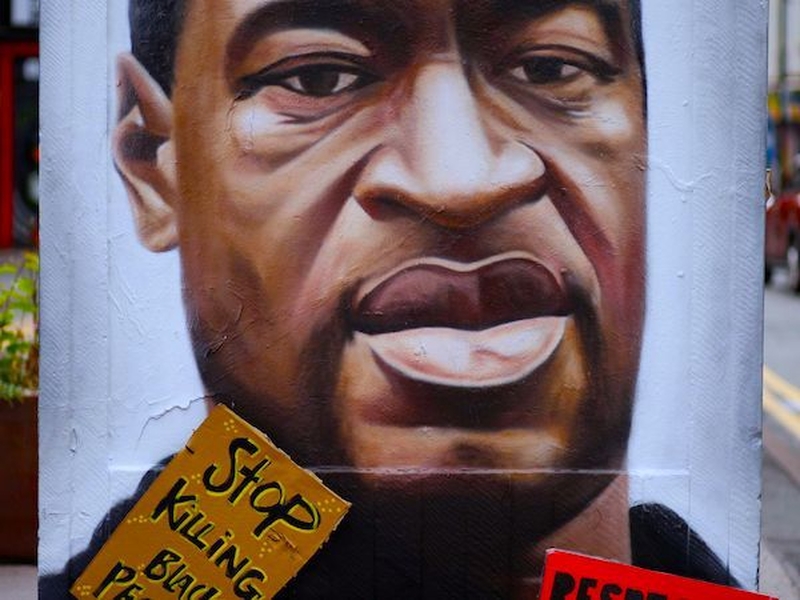
Not all subjects are as straightforwardly inspiring as an orchestra though. While we might all love Rashy, the image of George Floyd in the Northern Quarter hasn't pleased everyone. In fact, the mural has been defaced three times now, with racist intent being confirmed by police in two of the incidents.
The portrait of George Floyd (again painted by Akse) currently occupies the spot on Stevenson Square that is a focal point for the neighbourhood's street art. Those unhappy with the mural suggest that Mr Floyd's criminal record make him an unfit subject. For others, the memorialisation encapsulates the strength of feeling that the manner of his death provoked (George Floyd was killed by a police officer kneeling on his neck, sparking the summer's Black Lives Matter protests). The Twitter spat surrounding the image is interesting because it suggests that both sides see a street art portrait as somehow legitimising its subject and that by allowing it to be on the walls, the custodians of our public spaces - i.e. the council - endorse the content of the artwork.
This brings a debate that has troubled galleries and museums for decades into the streets. Essentially the question has been that if a museum is funded by public money, does that translate into a duty to prevent artworks that are controversial from being exhibited. And if so does this become a kind of censorship? If the streets are literally becoming art galleries, then they inherit the ethical issues that dog those institutions too.
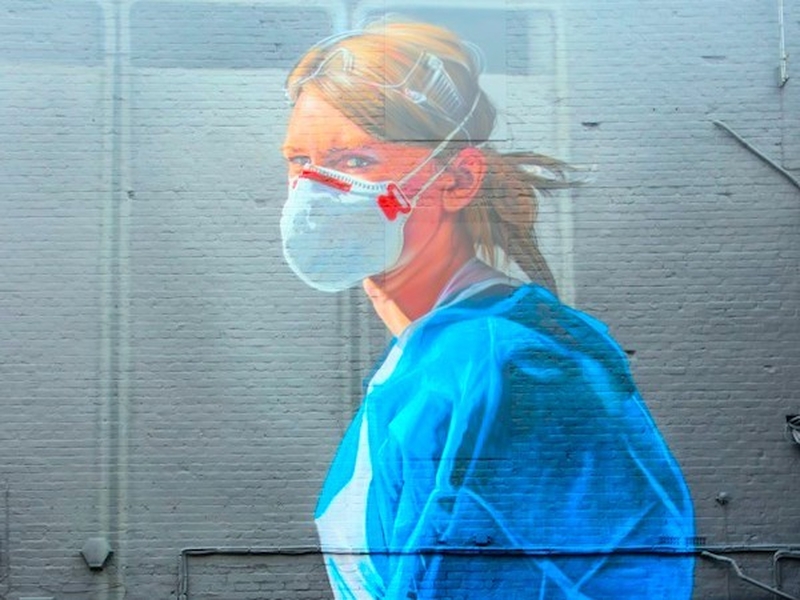
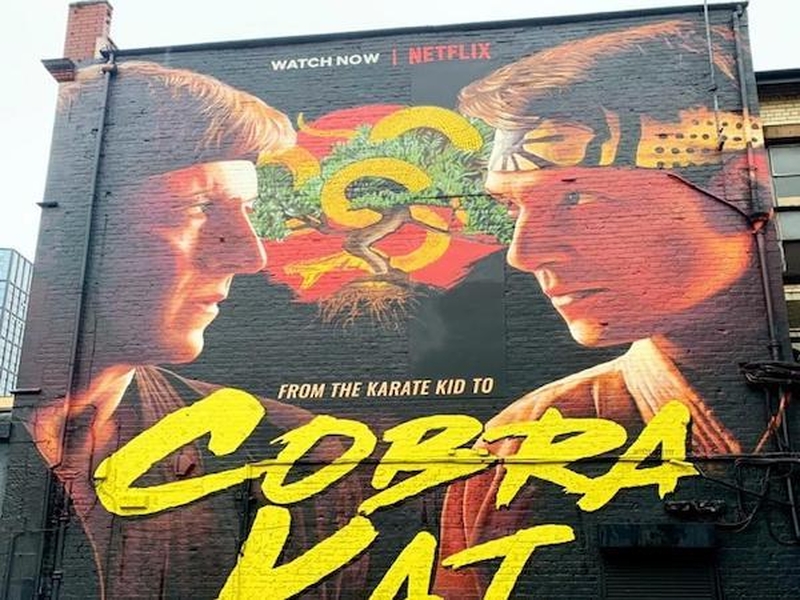
Art and the advertiser
Maybe the most symbolic of this mash-up between business, art, the council and cultural institutionalisation is the portrait of a nurse that took residence for a few months in the Northern Quarter. The image showed a nurse swathed in PPE, the worry and determination in her eyes the only expression visible in her masked face. It was a powerful representation of the light in which NHS workers were viewed through the first and subsequent lockdowns.
Artist Peter Barber was commissioned by the National Portrait Gallery and based his on a photograph taken by Johanna Churchill. The image is of Melanie Senior, a lead practice nurse and was part of the Hold Still project, an ambitious community initiative to create a collective portrait of the UK during lockdown. Funding came from the Co-Op, whose branding sat discreetly in one corner.
Here we had a piece of street art that captured the now-traditional heroic figure, pressing hard on the nerve of national sentiment. All properly funded and paid for but the involvement of the National Gallery meant that the money came at an artistically respectable remove, meaning fewer worries about the undue influence of commercial interests. The portrait was painted in late 2020. By February 2021 it had been painted over with an advert for Cobra Kai, a Netflix series.
While this might seem like a morality tale for street art, it trod a fine line. Technically it was corporate sponsorship but the artist himself described it as "the most poignant advert I have ever painted".
Transience is also part of the nature of street art - an attempt to preserve a Banksy on Tib Street backfired when the perspex that covered it became mouldy and opaque. So perhaps Trafford Blue shouldn't worry too much. After all, Marcus Rashford and co won't be there forever.





